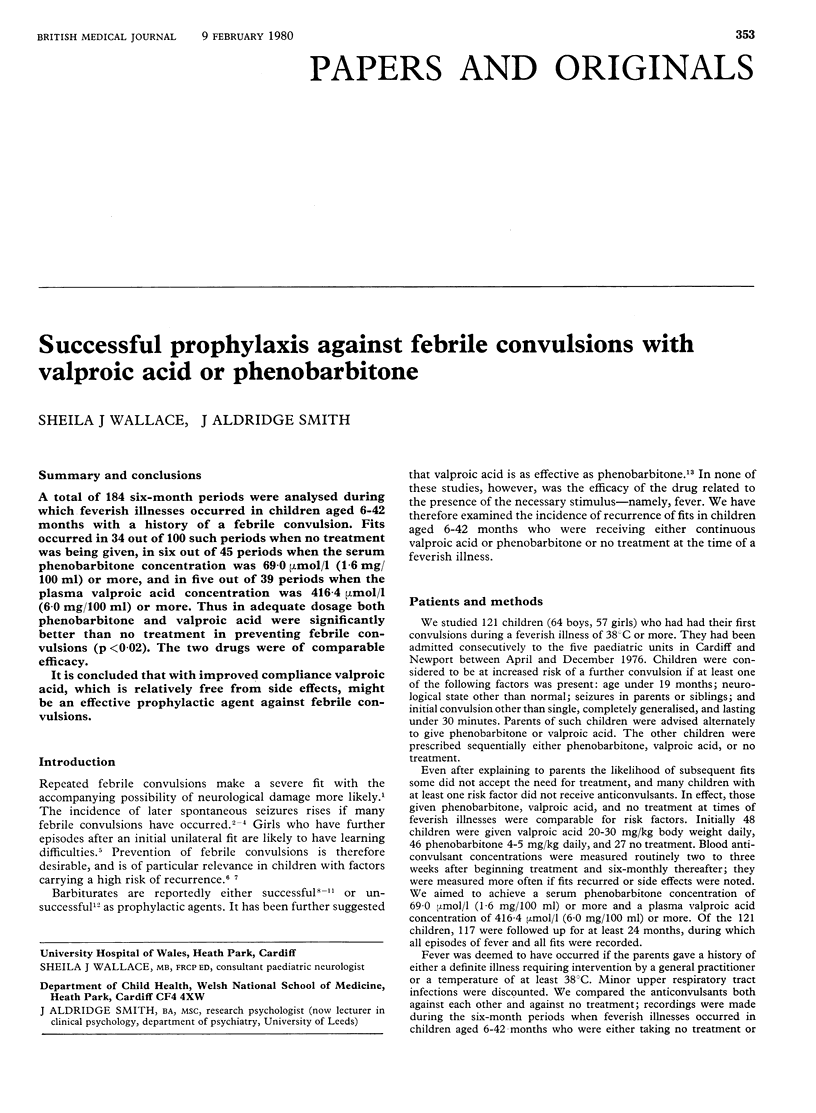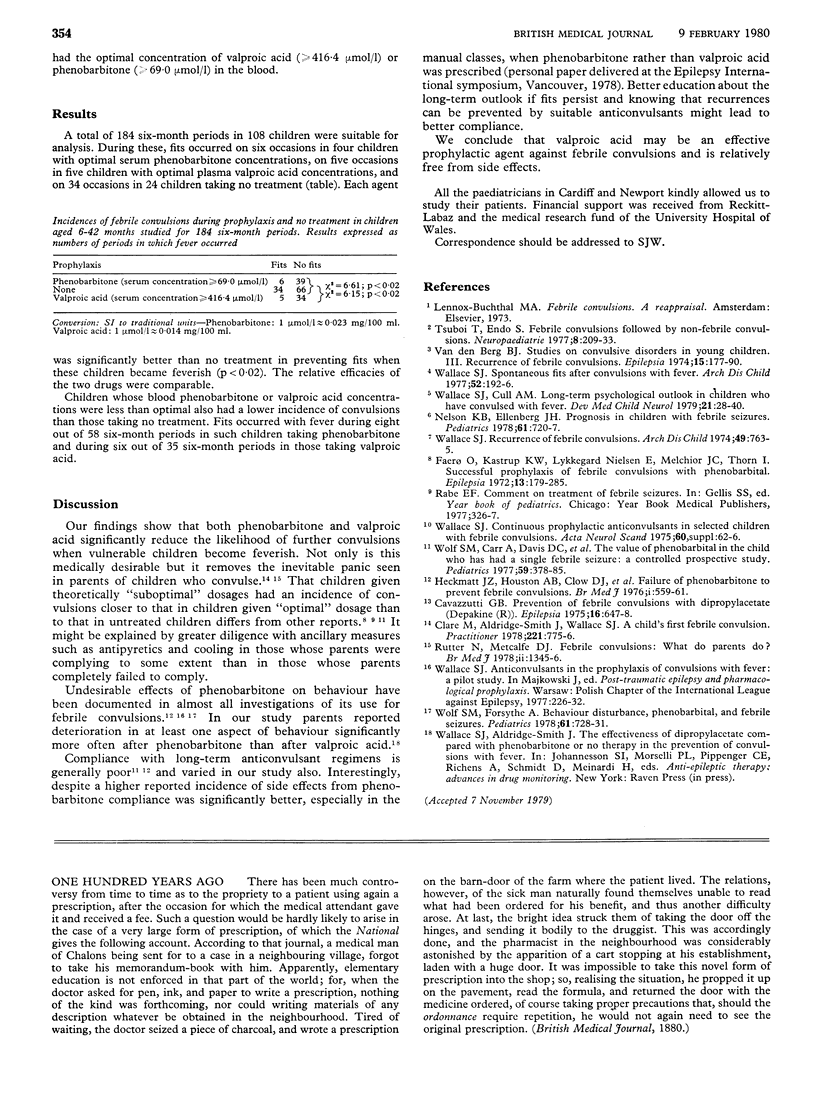Abstract
A total of 184 six-month periods were analysed during which feverish illnesses occurred in children aged 6-42 months with a history of a febrile convulsion. Fits occurred in 34 out of 100 such periods when no treatment was being given, in six out of 45 periods when the serum phenobarbitone concentration was 69.0 mumol/l (1.6 mg/100 ml) or more, and in five out of 39 periods when the plasma valproic acid concentration was 416.4 mumol/l (6.0 mg/100 ml) or more. Thus in adequate dosage both phenobarbitone and valproic acid were significantly better than no treatment in preventing febrile convulsions (p less than 0.02). The two drugs were of comparable efficacy. It is concluded that with improved compliance valproic acid, which is relatively free from side effects, might be an effective prophylactic agent against febrile convulsions.
Full text
PDF

Selected References
These references are in PubMed. This may not be the complete list of references from this article.
- Cavazzuti G. B. Prevention of febrile convulsions with dipropylacetate (Depakine). Epilepsia. 1975 Nov;16(4):647–648. doi: 10.1111/j.1528-1157.1975.tb04746.x. [DOI] [PubMed] [Google Scholar]
- Clare M., Smith J. A., Wallace S. J. A child's first febrile convulsion. Practitioner. 1978 Nov;221(1325):775–776. [PubMed] [Google Scholar]
- Faero O., Kastrup K. W., Lykkegaard Nielsen E., Melchior J. C., Thorn I. Successful prophylaxis of febrile convulsions with phenobarbital. Epilepsia. 1972 Apr;13(2):279–285. doi: 10.1111/j.1528-1157.1972.tb05262.x. [DOI] [PubMed] [Google Scholar]
- Heckmatt J. Z., Houston A. B., Clow D. J., Strephenson J. B., Dodd K. L., Lealman G. T., Logan R. W. Failure of phenobarbitone to prevent febrile convulsions. Br Med J. 1976 Mar 6;1(6009):559–561. doi: 10.1136/bmj.1.6009.559. [DOI] [PMC free article] [PubMed] [Google Scholar]
- Nelson K. B., Ellenberg J. H. Prognosis in children with febrile seizures. Pediatrics. 1978 May;61(5):720–727. [PubMed] [Google Scholar]
- Rutter N., Metcalfe D. H. Febrile convulsions--what do parents do? Br Med J. 1978 Nov 11;2(6148):1345–1346. doi: 10.1136/bmj.2.6148.1345. [DOI] [PMC free article] [PubMed] [Google Scholar]
- Tsuboi T., Endo S. Febrile convulsions followed by nonfebrile convulsions. A clinical, electroencephalographic and follow-up study. Neuropadiatrie. 1977 Aug;8(3):209–223. doi: 10.1055/s-0028-1091518. [DOI] [PubMed] [Google Scholar]
- Van den Berg B. J. Studies on convulsive disorders in young children. 3. Recurrence of febrile convulsions. Epilepsia. 1974 Jun;15(2):177–190. doi: 10.1111/j.1528-1157.1974.tb04940.x. [DOI] [PubMed] [Google Scholar]
- Wallace S. J., Cull A. M. Long-term psychological outlook for children whose first fit occurs with fever. Dev Med Child Neurol. 1979 Feb;21(1):28–40. doi: 10.1111/j.1469-8749.1979.tb01578.x. [DOI] [PubMed] [Google Scholar]
- Wallace S. J. Recurrence of febrile convulsions. Arch Dis Child. 1974 Oct;49(10):763–765. doi: 10.1136/adc.49.10.763. [DOI] [PMC free article] [PubMed] [Google Scholar]
- Wallace S. J. Spontaneous fits after convulsions with fever. Arch Dis Child. 1977 Mar;52(3):192–196. doi: 10.1136/adc.52.3.192. [DOI] [PMC free article] [PubMed] [Google Scholar]
- Wolf S. M., Carr A., Davis D. C., Davidson S., Dale E. P., Forsythe A., Goldenberg E. D., Hanson R., Lulejian G. A., Nelson M. A. The value of phenobarbital in the child who has had a single febrile seizure: a controlled prospective study. Pediatrics. 1977 Mar;59(3):378–385. [PubMed] [Google Scholar]
- Wolf S. M., Forsythe A. Behavior disturbance, phenobarbital, and febrile seizures. Pediatrics. 1978 May;61(5):728–731. [PubMed] [Google Scholar]


